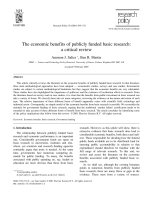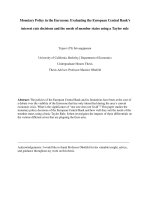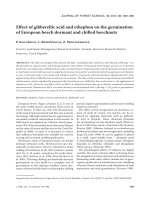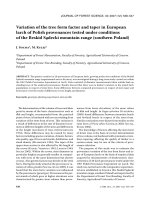Issues of the European transport policy and current state of eu funded transport research
Bạn đang xem bản rút gọn của tài liệu. Xem và tải ngay bản đầy đủ của tài liệu tại đây (128.94 KB, 12 trang )
Yugoslav Journal of Operations Research
12 (2002), Number 1, 109-120
ISSUES OF THE EUROPEAN
EUROPEAN TRANSPORT POLICY AND
CURRENT STATE OF EU FUNDED TRANSPORT RESEARCH
RESEARCH
George A. GIANNOPOULOS
Aristotle University of Thessaloniki,
Hellenic Institute of Transport, Thessaloniki, Greece
Abstract: This paper sets out the main lines of the existing EU Transport Policy, and
transport research. After a brief description of the main elements of this policy, a
discussion is given of its relation with transport research and the basic orientations
that existed under the previous Framework Programmes for EU funded research. Then
the main elements of the policy for the new (6th) Framework Program are presented.
Keywords: Transport policy, transport research, information society, intelligent transport
systems, transport telematics.
1. INTRODUCTION
The present paper is the result of a series of lectures which the author gave at
the Faculty of Transportation and Traffic Engineering of the University of Belgrade in
April 2001.
The aim is to present the relation of the European Transport Policy to the
transport research funded by the EU, and at the same time to give an overview of the
current state and prospects of this research in the future.
Basically, the EU's programme of transport research follows the 4-year cycles
or Framework Programmes (FP) of research in all fields. We are currently entering the
6th FP of research and the rules are now set for funded research for the period 20022006. Within the overall outline of the 6th FP, transport related research falls under
two main streams: one related to the activities of the Directorate General for Transport
and Energy (DG TREN), and one related to the Directorate General for Information
Society (DG INFSO). The first is directly aimed at providing Transport Policy makers
with the necessary scientific and technical background to formulate and evaluate
policies, while the second is aimed at complementing the creation of the so-called
European Information Society by providing the creation and implementation of
"Intelligent Transport Systems - ITS".
110
G. A. Giannopoulos / Issues of the European Transport Policy and Current State
It is hoped that the information in this paper will enhance an understanding
of the basic elements of the European transport policy, and at the same time research
objectives and requirements, so as to enable researchers who are not familiar with
these issues to get better chances at participating in European funded research
projects.
2. THE MAIN ELEMENTS OF THE EU TRANSPORT POLICY
In September 2001 the EU published a long awaited white paper detailing its
Transport Policy for the next decade. The title of this white paper speaks for itself:
"European Transport Policy for 2010: A Time to Decide"[9].
In it the Commission
Decide"
states the prime goals of its Transport Policy for the decade, its priorities in fulfilling
these goals, and the policy measures to achieve them.
There are four prime goals set out as follows:
1. Shifting the balance between the modes of transport
2. Eliminating bottlenecks in traffic flows in congested networks (all modes)
3. Placing the users at the heart of Transport Policy measures, and
4. Managing the globalization of transport.
Within each one of them, the white paper describes the priorities and the
specific measures and actions that it will take to fulfill them. In all, some 60 specific
policy measures are stated in the paper, which will be taken at EU level under this
policy until 2010. At the same time specific milestones are set along the way, notably
for monitoring exercises and a mid-term review of the policies followed (i.e. in 2005) in
order to check whether the precise targets are being attained and what are the
adjustments that are necessary. A most notable feature of the white paper is the
specific mention (and hopefully commitment) that the Transport Policy is to be made
consistent and adjusted continuously with regard to other relevant Commission policies
namely: the economic, the urban and land-use, the social and education, the urban
transport, the budget and fiscal, the competition, and the transport research policies.
By implementing these 60 policy measures the Commission expects that there
will be, by 2010, a marked break in the link between transport growth and economic
growth, without there being any need to restrict the mobility of people and goods. For
example they expect that between 1998 and 2010 there will be an increase of 38% in
road haulage instead of 50% if current trends prevail, and in passenger transport by car
an increase of 21% against a rise of 43% in GDP.
A brief reference to the main areas and priorities where these 60 policy
measures refer (as well as the most notable of these measures) is given below.
1.
Revitalizing the railways:
railways Here the priority is to open up rail markets with
further improvements in interoperability and safety, not only in international
services (as decided already in December 2000), but also in the national ones i.e.
lifting of the cabotage principle. Also the commitment is made that a network of
railway lines must be dedicated exclusively to goods services.
2.
Improving quality in the road transport sector
sector: The measures foreseen
under this policy area include: modernization of the way in which road transport
G. A. Giannopoulos / Issues of the European Transport Policy and Current State
111
services are operated (while complying with the social regulations and workers
rights), and tightening inspection procedures in order to put an end to practices
preventing fair competition. Also to put up legislation to protect carriers from
consignors and enable them to revise their tariffs in the event of rises in fuel
prices.
3.
Promoting transport by sea and inland waterways.
waterways Short sea shipping is
seen as a desirable alternative to build "veritable sea motorways" within the
framework of the Trans-European Networks. Also tougher rules on maritime
safety, a genuinely European maritime traffic management system, as well as a
tonnage based taxation system are to be set in place. For the inland waterways
their position as "intermodal waterway branches" is foreseen, and modern
transshipment facilities as well as revised inland waterway vessel characteristics
are to be promoted.
4.
Striking a balance between air transport growth and the environment:
environment
Here a reorganization of European air transport is foreseen to create the
"European single sky" as concerns air traffic management. Also to expand airport
capacity while at the same time introducing new regulations to reduce noise and
pollution caused by aircraft.
5.
Turning "intermodality" into reality: This area is aimed at technical
harmonization and interoperability between systems particularly for containers,
and to promote "sea motorways" by targeting innovative appropriate initiatives.
This, last, policy is to be effected through a new Community support programme
called "Marco Polo".
Polo"
6.
Building the TransTrans-European Transport Networks: Based on the experience
gained so far from the development of the Trans-European Networks (especially
the development of the 14 priority projects adopted by the Essen European Council
and the application of the guidelines adopted in the 1996 European Parliament and
Council decision, the white paper states that the Commission will concentrate on
the revision of the current Community guidelines for the development of the
Trans-European Networks. This revision will aim at removing the bottlenecks in
the railway network, and completing the routes that are identified as priorities for
absorbing traffic flows generated by the enlargement, particularly in frontier
regions. The new revision will also be aimed particularly at introducing the concept
of "sea motorways", developing airport capacity, linking the outlying regions on the
European continent more effectively, and connecting the networks of the candidate
countries to the networks of the EU countries.
7.
Improving Road safety: A number of actions are planned at improving road
safety from exchanging good practices, to harmonizing signs (especially for
dangerous black spots) and rules for checks and penalties for international
commercial transport.
8.
Adopting a common policy for charging for transport: The general principle
is the equal treatment for operators and between the modes of transport as regards
the price for using infrastructure. Two basic guidelines are adopted in that respect:
112
G. A. Giannopoulos / Issues of the European Transport Policy and Current State
•
•
9.
Harmonization of fuel taxation for commercial users, particularly in road
transport, and
alignment of the principles for charging for infrastructure use
(integrating the external costs [8]).
Recognizing
Recognizing the rights and obligations of the users: Perhaps the most
significant feature of this new Transport Policy of the Commission is the
recognition of the rights and obligations of the users.
users In this respect Community
legislation is to be put in place for helping transport users to understand, and
exercise their rights. For example, air passenger's rights to information, and
compensation for denied boarding due to overbooking and compensation in the
event of an accident.
10. Developing high quality urban ttransport
ransport: In this respect the Commission
places emphasis on exchanging of good practices aiming at making better use of
public transport and existing infrastructure. All measures to improve the quality of
urban transport must be compatible with the requirements for sustainable
environment and the Kyoto treaty provisions.
11. Putting research and technology at the service of clean, efficient
transport: Under this area specific actions are promised for cleaner, and safer
road and maritime transport and on integrating intelligent systems in all modes to
make for efficient infrastructure management. Specific mention is made to the
expectations from the new 6th Framework Programme (6th FP) for Research and
Development and the new policy for creating the integrated "European Research
Area - ERA", and the e-Europe action plan. Also in line with the policy priorities
under the previous areas some specific foci for the research, are mentioned for:
safety standards in tunnels, harmonization of the means of payment for certain
infrastructure (particularly motorway tolls), and improving the environmental
impacts of air transport (noise, safety, and fuel consumption).
12. Managing the effects of globalization: This area calls for actions that will
strengthen the Commission's position and presence in international organizations
concerning transport, such as the International Maritime Organization (IMO), the
International Civil Aviation Organization (ICAO), and the Danube Commission.
13. Developing medium and longlong-term environmental objectives
objectives for a
sustainable transport system: This area aims at creating a package of proposals
for measures that if implemented by 2010 will re-direct the common transport
policy towards meeting the need for sustainable development. The priority is set to
proceed to the adoption of pro-active measures (some of them admittedly difficult
to accept by the public) for the implementation of new forms of regulation in order
to channel future travel demand for mobility and to ensure that the whole of
Europe's economy develops in a sustainable fashion.
The above new, Transport Policy guidelines are to be further detailed and
specified within the coming years and will be under continuous monitoring and review
in order to take account of the results of previous actions and to be always in line with
current developments. The present author believes that the white paper is a good basis
for developing a coherent and integrated transport system. What remains to be seen is
G. A. Giannopoulos / Issues of the European Transport Policy and Current State
113
the extend to which the Commission and the national governments of the member
states will proceed to formulating and implementing the necessary actions that will
give substance to this policy document and give the citizens of Europe the benefit of a
more efficient, safe, and intelligent European transport system.
3. OTHER TRANSPORT POLICY RELATED ISSUES
The free movement of people and goods within and across national boundaries
is the ultimate objective of any transport policy with an international perspective. For
EU Member States this is a central prerequisite of the European Single Market, and
one that has gradually been achieved to a great extent between the EU's member
states.
Although most of the governments pursue the above basic principle of the
International Transport Policy, other important policy objectives, namely the
commitments to sustainability and environmental protection (ref. the 1992 Rio
Convention and the 1997 Kyoto Protocol), require transport systems to develop within
a framework that respects environmental and social, as well as economic, imperatives.
Industrial competitiveness, employment, quality of life and sustainable growth
are also very important considerations that all depend on European countries being at
the cutting edge in the development and deployment of new technologies in various
fields and transport as well. Thus the so-called "Information Society Technologies"
(including Intelligent Transport Systems - ITS)
ITS to achieve the European Information
Society are among the most important applications in the realisation of the abovementioned basic goals.
Information
Society
Citizen and business service
Transport
Telematics
Applications
for Transport
Sustainable mobility
Telecoms network
Transport network
Figure 1: Converging information and transport policies
114
G. A. Giannopoulos / Issues of the European Transport Policy and Current State
One of Europe's major challenges is to integrate ITS applications and services
across stakeholder interests and transport modes to provide seamless intermodal
transport for both goods and passengers. This process has started, but greater efforts
will be needed. The convergence of the objectives of the EU's Transport Policy and the
objectives for a European Information Society created the need for advanced research
in what has been known for many years as "telematics applications in transport". Thus
transport research has become an integral part of policy formulation (Fig. 1).
4. THE TRANS-EUROPEAN NETWORKS (TENS)
These networks cover telecommunications and energy, as well as transport.
They are basically a delineation of major axes of movement, telecommunications, or
energy infrastructures and are promoted as a Master Plan. Transport TENs (or TENTs) are designed to strengthen European cohesion by encouraging economic
integration, ensuring better long-distance communications (especially between remote
and under-developed areas and central regions), and providing the basic infrastructure
for the movement of people, goods, services and information across the internal
frontiers of EU member states.
The Trans-European Transport Network (TEN-Transport) is due to be
established by 2010 through progressive integration of surface and air transport across
the EU. It comprises road, rail, air and waterborne network sectors (the road sector
being known as the Trans-European Road Network, TERN).
An action plan [1], proposed by the EC and endorsed by EU member states,
supports private-sector developments aimed at financing and deploying the
infrastructure required for the TEN-Ts realisation. The EC has also published a
number of other policy documents that impact on mobility, including:
•
The Citizen's Network [2] - which outlines means of achieving integrated public
transport systems with easy interconnections between networks;
•
Towards Fair and Efficient Pricing in Transport [3] - which advocates
differentiated transport pricing to encourage more sustainable transport choices;
•
A New Approach to Maritime Strategy [4] - which focuses on shipping registers and
common applications on internationally-agreed rules of safety;
•
Communication on Intermodal Freight Transport [5]- which proposes optimal
integration of different transport modes to encourage the efficient and costeffective use of the transport system through seamless, customer-oriented door-todoor services; and
•
The e-Europe Initiative [6] - a set of 10 priority actions to promote electronic
commerce with target dates.
G. A. Giannopoulos / Issues of the European Transport Policy and Current State
115
5. OBJECTIVES AND BROAD LINES OF THE EU's NEW
RESEARCH ACTIVITIES
Activities under the 6th Framework Programme for research and technological
development (2002-2006) will be carried out in accordance with the following three
general objectives:
−
−
−
strengthening the scientific and technological bases of Community industry;
encouraging it to become more competitive;
promoting research activities deemed necessary by virtue of other chapters of
the Treaty.
In order to achieve these objectives more effectively, the new Framework
Programme will be restructured around three targets:
1.
2.
3.
integrating European research;
forming and structuring a European Research Area;
Area
strengthening the foundations of the European Research Area.
The notion of a "European
European Research Area"
Area" i.e. a "unified research space"
within which there will be uniform research priorities, funding, and exchanges, covers
all 15 member countries and it will obviously be extended eventually to new members
too.
The activities carried out in order to achieve the last two targets are intended
to structure various dimensions of the European Research Area that are closely
connected with research and constitute its environment, as well as helping to establish
or consolidate the foundations underpinning its operation. They will therefore be
implemented across the whole field of science and technology and not only transport.
Activities carried out to further the first objective, which will represent the
bulk of the efforts deployed under the 6th Framework Programme, are intended to
integrate research efforts and activities on a European scale. They will be carried out:
−
in a limited number of priority thematic areas exclusively by means of strongly
integrating, powerful instruments: networks of excellence, integrated projects and
EU participation in national research programmes implemented jointly pursuant
to Article 169 of the Treaty;
−
in areas corresponding to anticipating EU science and technology needs in the
form of certain specific needs of EU policies or new emerging needs;
−
in the field of science and technology as a whole in the case of complementary
research activities for SMEs.
International cooperation activities will be an integral part of the activities
carried out under the first target of the new Framework Programme. They may take
the form of:
− priority thematic areas;
−
initiatives aimed at securing for Europe a leading role in international research
efforts on global issues, and ensuring a coherent contribution by Europe therein;
116
G. A. Giannopoulos / Issues of the European Transport Policy and Current State
−
integrated bilateral cooperation activities with third countries1 or groups of third
countries;
−
the participation of third country researchers and organisations in projects and
networks in areas of particular interest to those countries.
As a fundamental and general principle, the rule of support on the basis of
competitive calls for proposals and the evaluation of the scientific and technological
quality of those proposals, by means of peer reviews, will be used to implement the bulk
of the activities under the 6th Framework Programme.
6. INSTRUMENTS AND DETAILED RULES FOR COMMUNITY
FINANCIAL PARTICIPATION
To help bring about the European Research Area, the Community will
contribute financially, under specific programmes, to research and technological
activities, including demonstration activities, carried out in the priority thematic areas
of the Framework Programme as well as in other areas and other themes in the field of
science and technology [10].
The Community's financial contribution to these activities will incorporate
measures to encourage innovation and will be carried out by means of a range of
instruments described below.
The following apply to all areas of research including transport.
6.1. Instruments to integrate research
6.1.1. Networks of excellence
In the priority thematic areas of research under the Framework Programme,
financial contribution will be provided to form networks of excellence.
Support to these networks is intended to promote excellence in Europe by
means of a deep and lasting integration of the excellence capacities existing in
universities, research centres and industries in several member states into a critical
mass of expertise by creating "virtual centres of excellence".
Integration will be ensured by means of a joint programme of activities
representing a substantial part of the activities of the entities' networked. The entities
will need to have or acquire the operational autonomy necessary to integrate their
activities gradually with those of other entities.
The programmes of activities, representing an order of magnitude of several
million euros per annum, will be defined on the basis of precise research themes and
topics, but not on the basis of pre-defined objectives or results. Implementing them will
entail the gradual integration of the work programmes in the areas concerned, a
1 Third countries: countries that are not members of the EU and are not associated with the
Framework Programme. The countries associated with the Framework Programme, whose
organisations and researchers can, by virtue of this association, participate in Framework
Programme activities under the same conditions as those of the Member States of the EU are: the
European Economic Area countries, the candidate countries, Switzerland and Israel.
G. A. Giannopoulos / Issues of the European Transport Policy and Current State
117
precise breakdown of activities, a significant volume of exchanges of personnel, and
intensive use of electronic information and communication networks and virtual and
interactive working methods. These programmes will necessarily and in a verifiable
manner involve activities to manage, transfer and exploit the knowledge produced.
The networks of excellence will be selected on the basis of calls for proposals.
Opening up participation in the networks of excellence to researchers from
other European countries than those of the associated entities will be encouraged by
means of measures in support of mobility. Participation in the networks of excellence
will in addition be open to third country organisations and European scientific
cooperation organisations.
6.1.2. Integrated projects
In the priority thematic areas of research of the Framework Programme,
financial contribution to integrated projects is planned. Consortia often involving
intense university/industry collaboration will carry out these projects, representing an
order of magnitude of up to several tens of millions of Euros.
The projects may cover "risky" research and will in all cases have clearly
defined objectives in terms of scientific and technological knowledge or products,
processes or services. The integrated projects may in some cases be made up of clusters
dedicated to different aspects of one and the same objective, integrated into a single
action by industry and public sector research partners on the basis of a regularly
updated timetable.
Carrying them out will necessarily and in a verifiable manner entail activities
relating to the dissemination, transfer and exploitation of knowledge as well as the
analysis and evaluation of the economic and social impact of the technologies concerned
and the factors involved in their successful exploitation.
They will preferably be carried out on the basis of overall financing plans
involving significant mobilisation of public and private sector funding, and recourse to
other collaboration or funding schemes, in particular Eureka and the instruments of
the European Investment Bank and the European Infrastructure Fund.
The integrated projects will be selected on the basis of calls for proposals.
Participation in them will be open to third country organisations and organisations for
European scientific cooperation. There will be specific measures to encourage SME
participation.
Participants with a high level of autonomy will administer the networks of
excellence and the integrated projects. They will in particular have the possibility of:
•
associating other partners with the activities that they undertake;
•
defining projects of limited scale as components of their programmes of activity
and launching calls for proposals;
•
adapting the content of those programmes according to needs.
The implementation of the programmes of activities carried out by the
networks of excellence and in the context of the integrated projects will be regularly
evaluated.
118
G. A. Giannopoulos / Issues of the European Transport Policy and Current State
6.1.3. Participation in national programmes carried out jointly
In the priority thematic areas of research of the Framework Programme,
financial contribution to national programmes will be carried out jointly pursuant to
Article 169 of the Treaty.
The programmes concerned will be clearly identified programmes
implemented by governments or national research organisations. Their joint
implementation will entail recourse to a specific implementation structure. This may
be achieved by means of harmonised work programmes and common, joint or
coordinated calls for proposals. In appropriate cases, the development or operation of
common infrastructures may be involved.
The Community may contribute financially to the programmes carried out
jointly. Where those programmes are open to other European countries, the
Community may also support the participation of researchers, teams or institutions
from those countries.
7. DETAILED RULES FOR FINANCIAL ARTICIPATION
BY THE COMMUNITY
The Community has stated [10] that it will contribute financially towards
implementing the instruments defined below in compliance with the Community
framework for state aid to research and development, as well as international rules in
this area, and in particular the WTO Agreement on Subsidies and Countervailing
Measures. It will need to be possible to adjust the scale and form of financial
participation under the Framework Programme on a case-by-case basis, in
particular if funding from other public sector sources is available, including other
sources of Community financing such as the EIB and EIF.
In the case of participation of bodies from regions lagging in development,
when a project receives the maximum intensity of co-financing under the Framework
Programme or an overall grant, an additional contribution from the Structural Funds,
pursuant to Council Regulation (EC) No. 1260/99 [7], could be granted.
In the case of the participation of bodies from the candidate countries, an
additional contribution from the pre-accession financial instruments could be granted
under similar conditions.
Financial participation by the Community will be granted in compliance with
the principle of co-financing, with the exception of financing for studies, conferences
and public contracts. Depending on the nature of the different instruments, financial
participation by the Community may be of an overall nature or take the form of a grant
to the budgets for each of the steps in the implementation of the instruments.
Table 2 below shows the rules set out by the Commission for its funding of the
various research activities under the new research FP.
G. A. Giannopoulos / Issues of the European Transport Policy and Current State
119
Table 2: Rules for the Commission's financial participation in research projects
Financial participation
By the Community under the
Framework Programme
Instruments
Integrating research
2
1. Financial contribution to networks of
excellence.
The Community may award an overall grant on the
basis of the results from the implementation of a
common programme of activities.
2. Financial contribution to integrated
projects.
The Community may award a grant to the budget
of these projects corresponding to a maximum of
50% of their total cost.
3. Financial contribution to national
programmes carried out jointly.
The Community may award a grant to the budget of
jointly-executed activities corresponding to a
maximum of 50% of their total cost; it may cover on
an overall basis the participation of third country
researchers and organisations in the activities.
4. Financial contribution to activities
carried out in order to anticipate the
EU's scientific and technological
needs, including specific research
activities for SMEs and specific
international cooperation activities
The Community may award a grant to the budgets
of these activities corresponding to a maximum of
50% of their total cost and assume responsibility
for the entire budget of the JRC.
Structuring the European
Research Area.
1. Financial contribution to activities to
promote interaction between research
and innovation.
The Community may award a grant to the budgets
for these activities.
2. Financial contribution to the
development of human resources and
increased mobility.
The fellowships and support for excellence will be
of a global nature.
3. Financial contribution in support of
research infrastructures.
The Community may award a grant to the budgets
for the preparatory technical work, including
feasibility studies to a maximum of 50% of their
total cost; it may award an overall grant for transnational access and network development activities
and, on the basis of the results, for the
implementation of integrated initiatives; it may
award a grant to the budgets for the development of
new infrastructures corresponding to a maximum of
10% of their total cost.
4. Financial contribution towards the
development of harmonious relations
between science and society.
The Community may award a grant to the budgets
for these initiatives.
2 In the three categories of activities undertaken under "integrating research", Community
funding can cover the participation of bodies and researchers from third countries.
120
G. A. Giannopoulos / Issues of the European Transport Policy and Current State
Strengthening the found
foundations
ations
of the European Research Area.
1. Financial contribution to coordination
activities.
The Community may award a grant to the budgets
for these activities.
2. Financial contribution to measures in
support of the coherent development
of research policies.
The Community may award a grant to the budgets
for these measures.
8. CONCLUSIONS
The new Framework Programme for research and development in the EU
countries (in which associated countries can also participate), sets out a new and very
ambitious framework for conducting research activities. The main aim is to further
integrate these activities and make them more uniform and "European" rather than
"national" and varied.
Transport research will be carried out under several of the broad "headings" of
the new Framework Programme areas, which are not yet detailed. Transport research
under the new programme is, however, expected to be even more "integrated" with the
(transport) policy requirements as well as with the broad objective of creating the eEurope of the future.
To this end competition along with intense control to respect the existing
rules and regulations for the financing of this research are expected to be strengthened.
REFERENCES
[1]
EC Communication on an Action Plan Concerning Europe's Way to the Information Society,
COM (94) 347, 1994.
[2] The Citizen's Network, EC Green Paper, 1996.
[3] Towards Fair and Efficient Pricing in Transport, EC Directorate-General VII, 1996.
[4] A New Approach to Maritime Strategy. EC Proposal, COM(96)81, 1996.
[5] Communication on Intermodal Freight Transport, EC Proposal, COM(97)243, 1997.
[6] e-Europe Initiative, EC Proposal, COM(99)687, 1999.
[7] OJL (1999) 161, 1999.
[8] Costa Report, A5-034/2000, European Parliament, 2000.
[9] European Transport Policy for 2010: A Time to Decide, COM (2001) 370, DG TREN, 2001.
[10] Instruments and Detailed Rules for Community Financial Participation, COM(2001)94, 2001.









